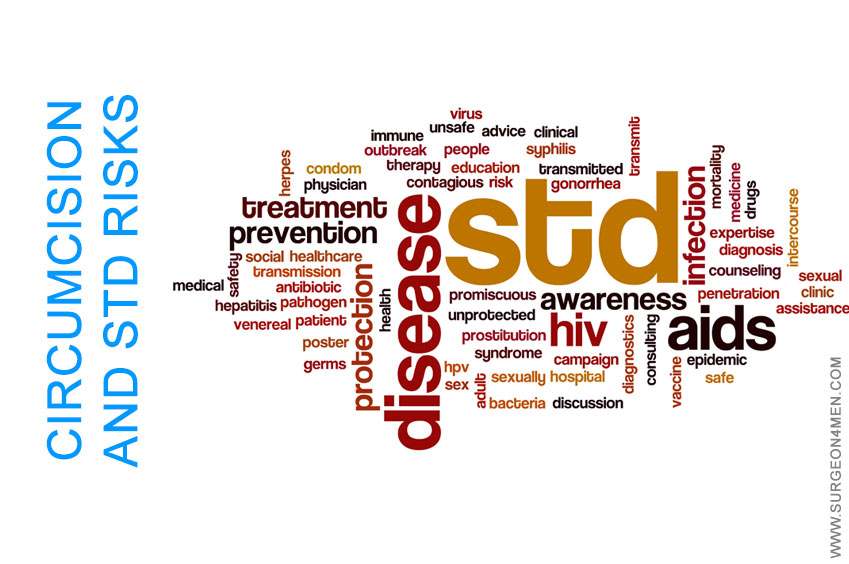Circumcision Reduces the Risk of Contracting STDs
Circumcision is a process that involves removal of the outermost skin that encloses the tip of the penis, via small surgical incision. It is very common in some parts of the world and is usually performed when the male is still very young. It is however, imperative to keep in mind that the procedure can also be performed on older boys with slightly increased risk of complications. Most families consider circumcision as a religious ritual or obligation. Other reasons for which people opt for circumcision are; personal hygiene or family customs. Some people however regard it as disfiguring or an unnecessary practice. Once circumcision is performed, it cannot be undone.
Why do People Opt for Circumcision?
 Circumcision is a considered as a cultural or a religious custom that is prevalent in Muslim and Jewish families along with some other aboriginal tribes present in Australia and Africa. At times it is also performed to cater certain medical needs, for example, too tight foreskin that is difficult to retract on top of the glans etc. In certain areas of the world such as Africa, older boys and men get circumcision to minimize the risk of contracting sexually transmitted diseases.
Circumcision is a considered as a cultural or a religious custom that is prevalent in Muslim and Jewish families along with some other aboriginal tribes present in Australia and Africa. At times it is also performed to cater certain medical needs, for example, too tight foreskin that is difficult to retract on top of the glans etc. In certain areas of the world such as Africa, older boys and men get circumcision to minimize the risk of contracting sexually transmitted diseases.
According to the American Academy of Paediatrics (AAP) when considering the risk-benefit ratio, the benefits of getting circumcision are greater than the risks. Nevertheless it doesn’t recommend all male newborn babies to get routinely circumcised. It is preferred to use anaesthetics for infants during the procedure.
The health benefits associated with circumcision are listed as:
- Maintenance of Hygiene: A circumcised penis is easier to wash. But cleaning the part under the foreskin is usually easy as well if the penis is uncircumcised.
- Fewer Chances of any UTIs: Usually men are at low risk of developing urinary tract infections after circumcision due to better sexual and genital hygiene. Severe urinary tract infections during early years of life can lead to kidney problems.
- Forestalling the Penile Problems: At times foreskin retraction becomes nearly impossible or difficult to manage in some uncircumcised penis; thereby leading to phimosis. The persistent inflammation and ongoing irritation can affect the quality of physical and sexual life of an individual.
- Fewer Chances of Penile Cancer: Penile cancer is extremely rare in circumcised men. Women who are sex partners with circumcised men are also believed to be a minimal risk of developing cervical cancer due to low rate of transmission of HPV.
Does Circumcision Reduces the Risk of Sexually Transmitted Diseases?
 Several research and clinical studies suggested that circumcision can directly minimize the chances of contracting sexually transmitted diseases such as HIV, HPV and others. For example, according to a new study reported in the African Journal of Reproductive Health (2), investigators concluded that the risk of HIV transmission is 4-times higher in uncircumcised males when compared to circumcised males. These results were conducted based on the data obtained from 70,554 adult males in the age range of (15 to 59 years). Additionally, report also suggested that circumcision can be used as a reliable method of reducing HIV transmission in populations.
Several research and clinical studies suggested that circumcision can directly minimize the chances of contracting sexually transmitted diseases such as HIV, HPV and others. For example, according to a new study reported in the African Journal of Reproductive Health (2), investigators concluded that the risk of HIV transmission is 4-times higher in uncircumcised males when compared to circumcised males. These results were conducted based on the data obtained from 70,554 adult males in the age range of (15 to 59 years). Additionally, report also suggested that circumcision can be used as a reliable method of reducing HIV transmission in populations.
Based on the data reported by Aaron A. R. Tobian and associates (3), it was observed that circumcision reduces the risk of HIV transmission by 51 – 60% and that of HSV –II by 32 – 35%.
It is to be noted that blood coagulation disorders or other circulatory issues are a relative contraindication to the circumcision. Additionally, it should be avoided in case of premature male babies who demands intensive medical care. It has no effect on the fertility and does not detract or enhance the pleasure while having sex with the partner.
Risks Associated With Circumcision
The 2 commonly associated complications with circumcision include infection and bleeding. Use of anaesthetics may also leave some transient side effects. Circumcision may very rarely give rise to foreskin problems such as:
- Too long or too short cut foreskin
- Improper healing of foreskin
- Attachment of the remaining foreskin to end of the penis that can be taken care of by minor surgery.
What to Expect?
- During the Procedure: In most developed parts of the world, circumcision is performed in the nursery of the hospital, between 1-10 days after the birth of the baby. Newborn babies are laid on their back, while their legs and arms are kept still. Once the penis and the area around it is cleaned, an anesthetic agent is injected or topically applied onto the base of the penis. A plastic ring or a clamp is tied to the penis followed by removal of the foreskin. After the circumcision is done, ointment such as petroleum jelly is applied on top of it and it is loosely wrapped with gauze. The time required for circumcision is usually 10 minutes. For adults/older boys, similar procedure is followed except few changes like use of general anesthesia and sutures to prevent bleeding.
- After the Procedure: for 7-1, will dro0 the penis may be sore, reddish, bruised or swollen, but it heals eventually. A yellow crust may also be observed on its tip initially. It’s advised to keep changing the bandage with every diaper change for newborns. It’s also okay to wash the penis once it heals. The plastic ring, if it were placed during the procedure, will come off itself within a week or so.
References:
- Van Howe, R. S. (2013). Sexually transmitted infections and male circumcision: a systematic review and meta-analysis. ISRN urology, 2013.
- Gebremedhin, S. (2014). Assessment of the protective effect of male circumcision from HIV infection and sexually transmitted diseases: evidence from 18 demographic and health surveys in sub-Saharan Africa. African Journal of Reproductive Health, 14(2), 105-113.
- Tobian, A. A., Kigozi, G., Wawer, M. J., Serwadda, D., Quinn, T. C., & Gray, R. H. (2013). Herpes simplex virus type-2 (HSV-2) assay specificity and male circumcision to reduce HSV-2 acquisition. AIDS (London, England), 27(1), 147.

